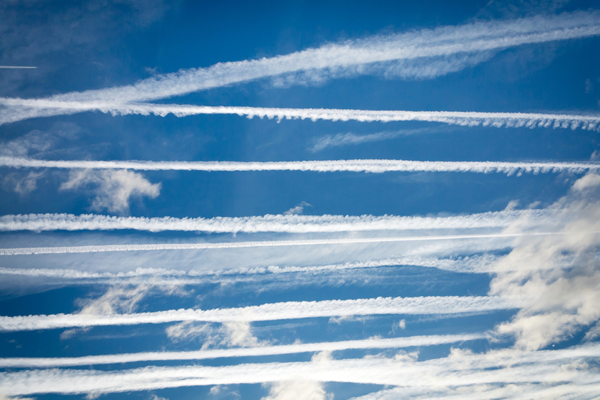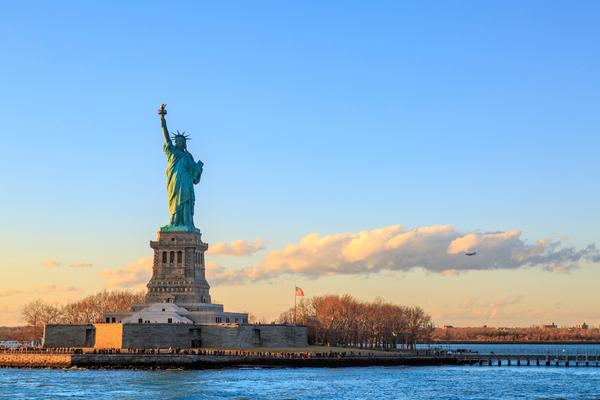An Our Country Our Choice Special Edition
The Panama Paradox
By Greg Taylor with Mary Otto-Chang HBA, MES, PhD (Candidate)
A Quick History Lesson: Panama and the Role Played by the U.S.A.
At Our Country Our Choice, we try our best to bring you correct and balanced information, which is evidenced-based. As such, we present an OCOC Special Edition Newsletter, as together we go digging deep into the paradox that is the Panama Canal.
In recent weeks, President Donald Trump has reignited discussions about U.S. foreign policy in Latin America, specifically focusing on the Panama Canal. His comments, which include threats to reclaim control of the canal, have stirred both national and international debates. President Trump’s speech at AmericaFest in Phoenix, Arizona, on December 22, 2024, addressed the Panama Canal and was both provocative and reflective of his “America First” policy.
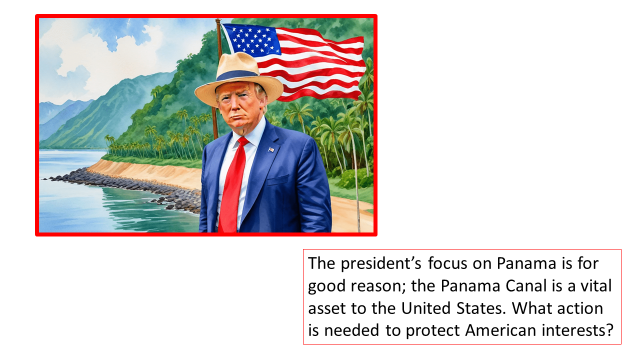
A Quick History Lesson: Panama and the Role Played by the U.S.A.
Before we consider what President Trump has said and what implications that may have, it is best to understand a little about Panama and the US’s integral role in the birth of the nation.
Panama, a slender isthmus bridging North and South America, has long been a focal point for strategic interests due to its unique geographical position. From the era of Spanish conquistadors through to the noteworthy events culminating in the 1977 Torrijos-Carter Treaties and beyond, Panama has played a significant role in international affairs.
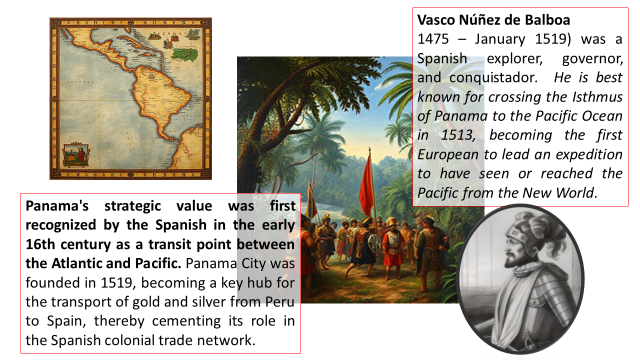
With the decline of Spanish power, Panama’s strategic value shifted but did not wane. In the 19th century, the prospect of a quicker trans-isthmus route intensified with the California Gold Rush.
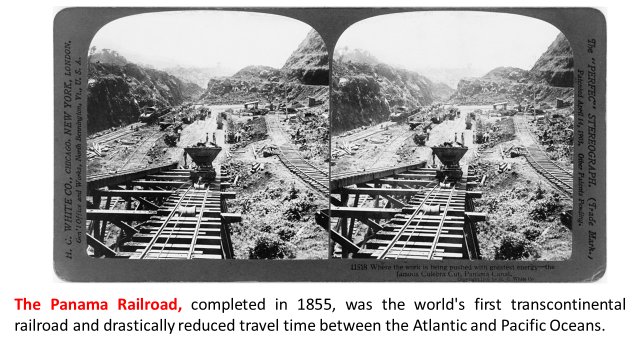
The railway was primarily constructed by American interests, highlighting the growing U.S. involvement in Panama’s affairs, driven by both economic and strategic motives.
The idea of a canal cutting through Panama was not new by the late 19th century. Initially, the French, under Ferdinand de Lesseps, who had successfully engineered the Suez Canal, attempted to build a sea-level canal in Panama. This project, fraught with engineering challenges, disease, and financial mismanagement, failed spectacularly by 1889. This debacle left Panama and its canal ambitions in limbo but did not diminish the strategic imperatives of such a waterway.
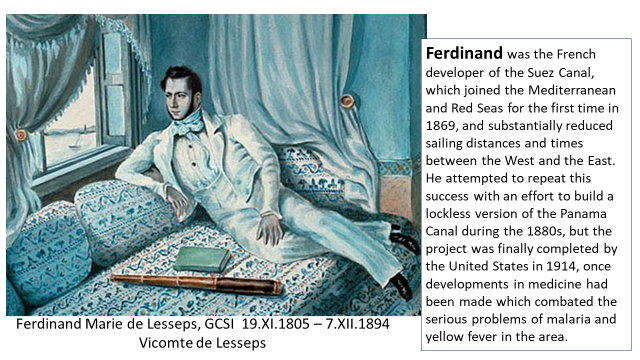
The United States, seeing the strategic importance of a canal through Panama for both naval supremacy and trade, seized the opportunity. In 1903, Panama declared independence from Colombia with U.S. support, motivated by the desire to secure canal rights. The U.S. recognized Panama’s independence swiftly, and within days, the Hay-Bunau-Varilla Treaty was signed, granting the U.S. control over the Panama Canal Zone. This act was not without controversy, as it involved significant U.S. diplomatic and military intervention.
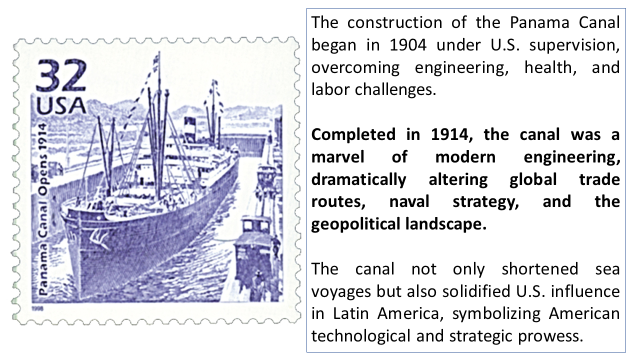
Throughout much of the 20th century, the Canal Zone operated as a de facto U.S. territory, often a point of contention in Panamanian-U.S. relations. Issues of sovereignty, economic benefits, and national pride came to a head in the 1960’s and 1970’s. In 1964, riots over flag-flying rights in the Canal Zone led to deaths and highlighted the need for a reevaluation of U.S.-Panama relations.
This tension led to the Torrijos-Carter Treaties of 1977, signed by U.S. President Jimmy Carter and Panamanian General Omar Torrijos. These treaties mandated the gradual transfer of control of the canal to Panama, with full control to be handed over by the end of the century on December 31, 1999. This agreement was revolutionary, acknowledging Panamanian sovereignty over its territory, while ensuring the canal would remain an international waterway.
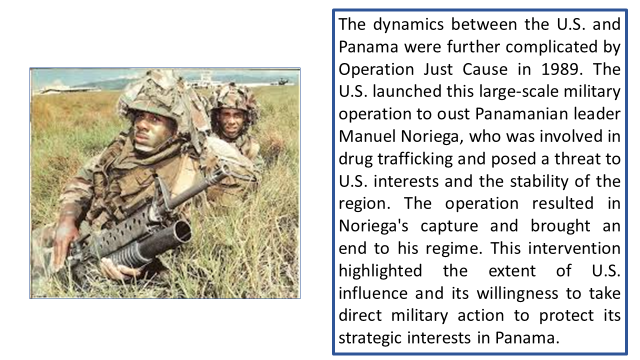
On December 31, 1999, the Panama Canal was officially handed over to Panama, marking the culmination of the Torrijos-Carter Treaties. This historic event symbolized Panama’s full sovereignty over the canal and its territory.
In the 20th Century, the history of Panama and the United States were intertwined. Panama would not be the nation it is without the help and protection of the US.
National Interest
Back to recent weeks and President Trump’s speech at AmericaFest– in it he emphasized the canal’s importance to U.S. national security and economy, saying, “The Panama Canal is considered a VITAL National Asset for the U.S., due to its critical role in America’s Economy & Security.” Trump mentioned concerns about the canal falling into “wrong hands,” specifically citing potential Chinese influence.
What cannot be underestimated is the importance of Panama, both the canal and the country itself, to the national security of the US. President Trump is also correct to highlight the influence of China in the country.
Panama’s strategic importance to the United States is primarily due to its geographical location, which serves as the narrowest point between North and South America, making it a crucial chokepoint for global maritime trade. The Panama Canal, completed by the U.S. in 1914, has been a pivotal asset for American naval strategy and commerce, significantly reducing travel time for ships moving between the Atlantic and Pacific Oceans. This canal not only facilitates the swift movement of U.S. naval forces but also supports extensive trade routes that are vital for U.S. economic interests. Approximately 66% of the cargo traffic transiting the Canal either begins or ends its journey at a U.S. port, highlighting the U.S.’s reliance on this waterway for both security and economic reasons.
In terms of world trade, the canal accommodated the transit of approximately 5% of world maritime shipments with just over eight million containers traversing the waterway per year. Both for the US and the world in general the canal is important. As the world’s manufacturing hub, that has brought great interest from China.
Recollections Do Vary
President Trump’s critique of the handling of the canal seems to hinge on a nostalgic view of American dominance but overlooks the waterway’s current administration by the Panama Canal Authority and the international treaties that govern its operations. His comments also serve as a broader assessment of global trade dynamics where the U.S. feels disadvantaged, particularly considering China’s economic maneuvers in the region.
We should all by now be aware that Mr. Trump often uses a liberal interpretation of facts in to discuss matters and establish a starting point for negotiation. Several of the claims by President Trump during his speech at AmericanFest seem to be a little outside of conventional interpretation of history. A fact check may be in order.
-Deaths
There was an allegation that 38,000 Americans lost their lives in the building of the canal. Mr. Trump seems to be conflating the number of lives lost over the two phases of the canal. The construction of the Panama Canal saw approximately 25,000 to 30,000 deaths in total over both the French and American phases of construction. During the French attempt, around 20,000 to 25,000 workers died, mostly due to diseases like yellow fever and malaria. Very few of these workers were American.
The official U.S. records from the construction period document about 5,609 deaths. Approximately 350 American workers died, according to some sources. Other sources might cite slightly different numbers, but the consensus is that the number of American deaths was well below 1,000.
President Trump clearly has his number wrong.
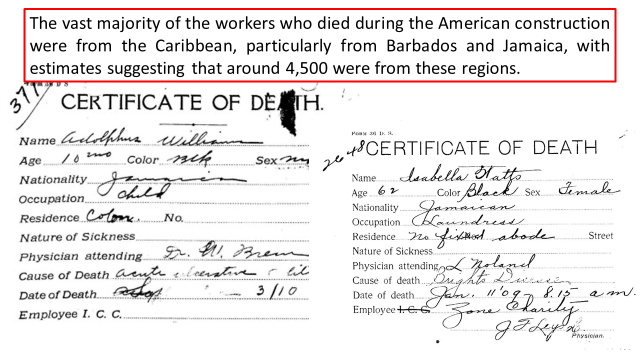
– Cost
President Trump said that the construction of the Panama Canal cost $1.3 billion in today’s money. The cost of the canal construction to America back in 1904 to 1914 was $375 million. Using the U.S. Bureau of Labor Statistics’ CPI Inflation Calculator, $375 million from 1914 (when the canal was completed) would be approximately equivalent to about $10.6 billion in January 2025 dollars. Even adjusting based on Purchasing Power Parity (PPP) the figure would still not exceed $12 billion. President Trump is out by a factor of over one hundred based on a base cost of $375m in 1914.
-1977 Handover Price
According to President Trump, President Carter gave the canal away for one dollar in 1977. “President Jimmy Carter foolishly gave it away – gave it away – for one dollar, one dollar during his term in office.” There is no evidence that any money was paid by Panama to the United States to take back the canal. The transfer was done by means of an international treaty alone.
-Exorbitant Prices
President Trump is particularly upset at the prices being charged by the Panama Canal Authority. As he put it, “It was likewise not given for Panama to charge the United States its navy and its corporations doing business within our country exorbitant prices and rates of passage….The fees being charged by Panama are ridiculous. Highly unfair.”
Compared to prices in 1977 to 2024, current costs are considerably higher than they would be if adjusted for inflation. At the same time, the dynamics of international trade have changed, there are far more international shipments, the ships are bigger, the canal has undergone a major expansion to accommodate Panamax sized vessels and more. Travelling through the Panama Canal is still likely to be far cheaper in terms of time and money than the alternative of rounding Cape Horn at the southern tip of South America.
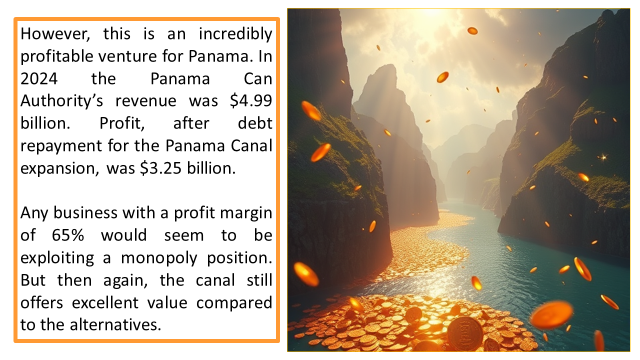
-Fair Treatment
The question of Chinese influence and the perception that this has led to the US being treated unfairly, played out large in the speech. As he stated, “The United States has a big, vested interest in the secure efficient and reliable operation of the Panama Canal. And that was always understood when they gave it to Panama. Can you believe that? We would never have done it if we had thought what is happening now could happen. And we would never, and we will never let it fall into the wrong hands. But it’s fallen into the wrong hands. It was not given for the benefit of others by a token of cooperation, but it was given to Panama and the people of Panama, but it has provisions you’ve got to treat us fairly and they haven’t treated us fairly. If the principles both moral and legal of this magnanimous gesture of giving are not followed then we will demand that the Panama Canal be returned to the United States of America in full, quickly and without question.”
Trump expects fairness. The truth is that tariffs are set in a transparent manner and there is no suggestion that different parties are charged different fees. However, it is understood that the US military does get preferential passage through the canal. The treatment the US receives from the Panama Canal is no worse, and probably better than other nations receive. In that sense, his comment on fairness misses the mark.
President Trump’s real focus here seems to be his perception that China has undue influence over the canal. There is certainly an increase of Chinese influence within Panama as a whole. As to whether that transfers to the canal itself is open for debate.
The Neutrality Treaty
The Carter-Torrijos Treaties, signed in 1977 by U.S. President Jimmy Carter and Panamanian General Omar Torrijos, were landmark agreements that redefined U.S.-Panama relations concerning the Panama Canal. They comprised two principal documents: the Panama Canal Treaty, which outlined the transfer of control of the canal from the U.S. to Panama, and the Treaty Concerning the Permanent Neutrality and Operation of the Panama Canal, commonly known as the Neutrality Treaty.
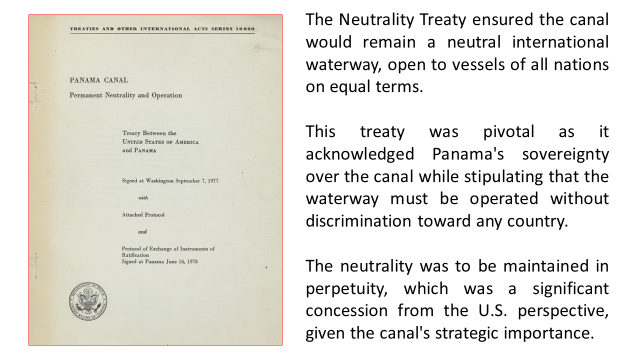
A critical aspect of the Neutrality Treaty is the provision allowing the United States to use military force to defend the canal’s neutrality. Article IV of the treaty explicitly states that the U.S. and Panama have the right to act independently to ensure the canal’s operations continue unimpeded. This clause was intended to protect the canal from any threat that might disrupt its function as a neutral passage. The practical implication was that the U.S. could intervene militarily if it perceived any threat to the canal’s neutrality or operation, a clause that was particularly significant during the Cold War era when threats were seen in ideological and geopolitical terms.
Even if the neutrality of the canal comes into question, the treaty does not allow for the United States to take back control and to run the canal. The military intervention is purely to address issues and bring back a state of neutrality to the canal.
China’s Growing Influence
As part of its Belt and Road Initiative (BRI), China has been actively expanding its influence in Panama. Since Panama switched diplomatic recognition from Taiwan to China in 2017, China has invested heavily in Panamanian infrastructure.
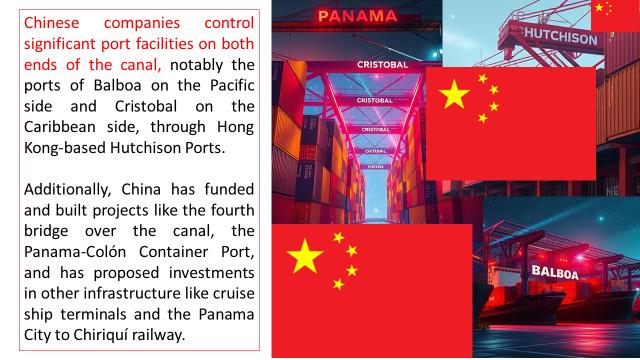
These initiatives aim to enhance China’s logistical reach in the Americas, aligning with the BRI’s goal of increasing global trade connectivity, but they also serve China’s strategic interests by establishing a presence near critical maritime routes.
With the rise of Chinese activities in Panama, there has been increasing scrutiny and concern over potential Chinese influence or control over strategic infrastructure. Although China does not directly control the canal, its economic presence has raised U.S. security concerns.
China’s activities are part of a broader strategy to extend its geopolitical influence in the Western Hemisphere, a region historically considered within the U.S.’s sphere of influence. The control of ports near the canal potentially allows China to influence canal operations or gather intelligence, even though direct control of the canal remains with Panama. Consider the intelligence the Chinese could gain from their ability to closely observe maritime movements through the canal in the event of a conflict such as an invasion of Taiwan.
A significant US concern will be that China’s investments might also shift economic dependencies, potentially reducing Panama’s reliance on U.S. infrastructure or economic support, thereby affecting U.S. strategic leverage in the region. There will also be unease about the dual-use potential of Chinese infrastructure, where commercial ports could serve military purposes in times of conflict, although no direct military presence has been established.
The U.S. has also expressed concerns over what it terms “debt-trap diplomacy,” where Chinese loans could lead to economic leverage over Panama, though this is a matter of debate. The U.S. has responded with diplomatic pushback and by promoting alternatives such as the U.S. International Development Finance Corporation. However, critics argue the U.S. has been slow or reactive in its strategic countermeasures.
Panama remains a focal point for U.S.-China strategic competition, with each country’s actions in the region likely to influence not only bilateral relations but also the broader geopolitical landscape in Latin America. But make no mistake, China is a strong influence within and around the Panama Canal.
Darien Gap
While focus may be on the Panama Canal, Panama is also strategic as a bridge between North and South America. Over the period of the Biden administration that link has gained international attention as a route for migrants on their journey to the US.
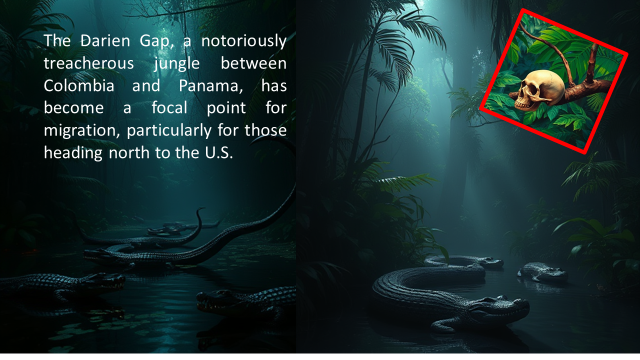
Here, too, Panama’s geopolitical landscape is shaped by external influences. While not directly, or perhaps more correctly stated transparently, linked to Chinese investments, the strategic value of Panama extends to this humanitarian crisis. Migrant camps have sprung up, supported by a mix of local, international NGOs, and U.S. aid, aiming to manage the flow of migrants.
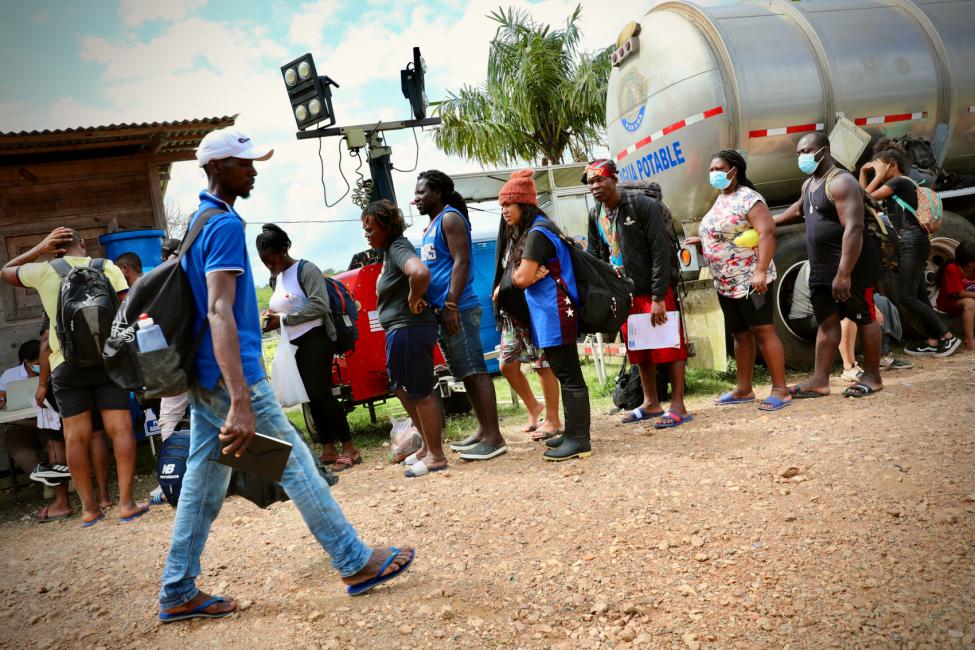
Photo Credit IOM
The U.S. State Department under the Biden Administration played a role in supporting these initiatives, reflecting a policy of managing, and even encouraging, migration at its source rather than at the U.S. border. However, this situation also showcases the complexities of international cooperation where economic interests intersect with humanitarian concerns.
As China expands its influence in Panama, it might also seek to leverage these dynamics for geopolitical gain, although concrete evidence of definitive Chinese government involvement in the migrant situation remains elusive.
While definitive involvement cannot be proven there is strong speculation that the Chinese have been highly influential in the Darien Gap. One person who has taken many trips to Panama and the Darien Gap is former Green Beret and now journalist, Michael Yon. In a 2024 interview of the Shawn Ryan Show, Mr. Yon explained the Chinese presence in Panama and the work that he believes they are doing, besides other things, to construct a bridge and eventually a path through the Darien, linking Panama to Colombia by road. He explains that this route through the Darien Gap is part of Chinas Belt & Roads Initiative that will eventually link up South American and North America including Brownsville and as far as Detroit on the I-69 corridor. He also explains how the migrant camps in the Darien are transporting 3,000 people each day, the majority of whom are Venezuelan and perhaps linked to terrorist groups, as well as hundreds of Chinese. At one stage during the interview Shawn Ryan asks, “China is obviously there to take control of the canal and the trade route, correct?” To which Michael Yon responds, “Yep.”
To the casual observer, it seems like the Biden State Department and NGOs have been purposely working in alignment with the Chinese in the Darien Gap against the US’s best interest. With a lack of interest from a legacy media in line with globalist aims, it is down to independent journalists like Mr. Yon to carry the torch and enlighten us to the truth.
Geopolitical Pivot
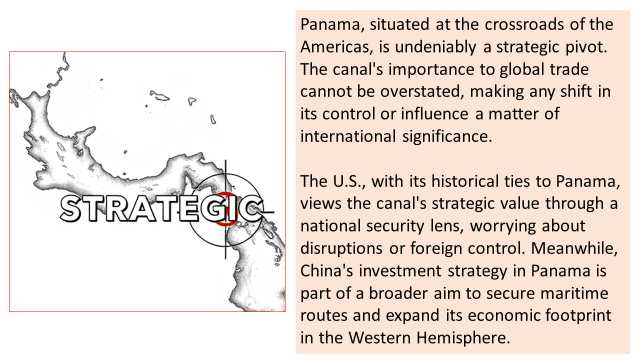
Many in the U.S. might wonder how the shift from U.S. to Chinese influence was allowed to happen. This was not a sudden change. Even considering the changes since 2017, when Panama diplomatically ditched Taiwan for China, that’s over seven years of the U.S. inaction. That has allowed China to gain a strategic advantage. If we go back to the handover of the canal on December 31, 1999, that’s 24 years of failing to maintain a healthy strategic relationship within Panama that could have minimized Chinese influence.
Over the past quarter-century, U.S. foreign policy has primarily focused on foreign wars in the Middle East post-9/11, more recently in Ukraine, and elsewhere. Domestically, serious issues included the 2008 financial meltdown, border issues, and the COVID-19 pandemic. Additionally, there has been a significant shift of manufacturing from the U.S., driven by globalization, influenced by lack of domestic investment, environmental and other regulations, and one-sided climate change action.
Aside from perhaps COVID-19, many of the distractions from the “vital national asset,” as President Trump calls the canal, have been deliberate foreign policy choices. It has in turn allowed China’s influence and Belt and Road Initiative to dominate Latin America, including Panama. Distractions have been few for China with no major wars to wage.
Added to that, domestic policy efforts to limit fossil fuel has hamstrung industry and restrained growth. This has directly led to the growth of China as the industrial hub of the world with no domestic of even international pressure to reduce fossil fuel use. China has taken advantage while the U.S. handed over its industry. That has led to a trade surplus of staggering proportions for China, allowing for the expansion of BRI into many countries including Panama.
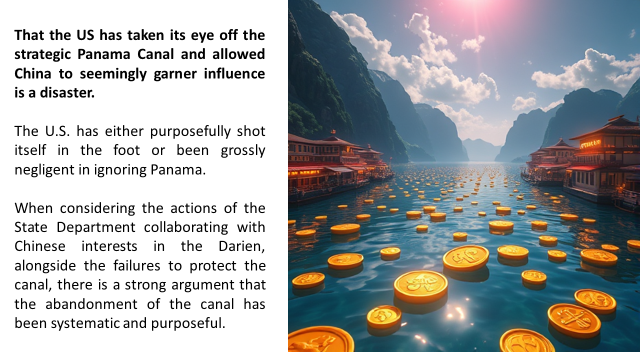
Taiwan
Another geopolitical consideration may be Taiwan if President Trump’s rhetoric about the U.S. taking control of the Panama Canal is to be believed. This proposal, if pursued through military action outside the provisions of the Neutrality Treaty, may be highly unwise. Instead, diplomacy and economic influence should be the primary tools to counter China’s growing presence in the region.
A key complication in Trump’s rhetoric is the potential analogy to China’s ambitions for Taiwan. While the underlying reasons differ—economic and national security for the U.S. versus reunification for China—any move by Trump to physically seize control of the Panama Canal could be seen as setting a precedent for China to do the same with Taiwan. This would undermine international norms and could escalate tensions globally.
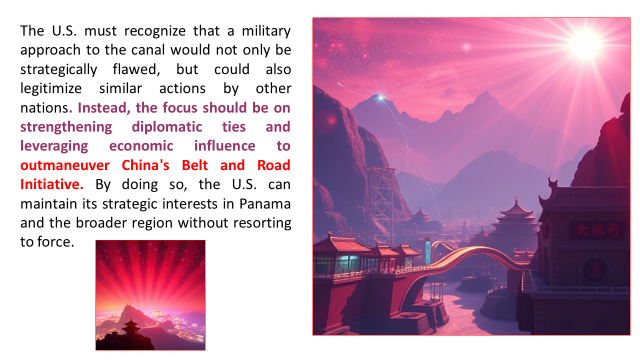
BRICS – Brazil, Russia, India, China, South Africa
Panama has previously considered seeking observer status within BRICS, highlighting the shifting dynamics in the region. This means the U.S. has a great deal to consider in terms of strategy if it chooses to regain control of the canal. A Trump Administration must recognize that military action outside the provisions of the Neutrality Treaty may be unwise. Instead, diplomacy and economic influence should be the primary tools to counter China’s growing presence in the region.
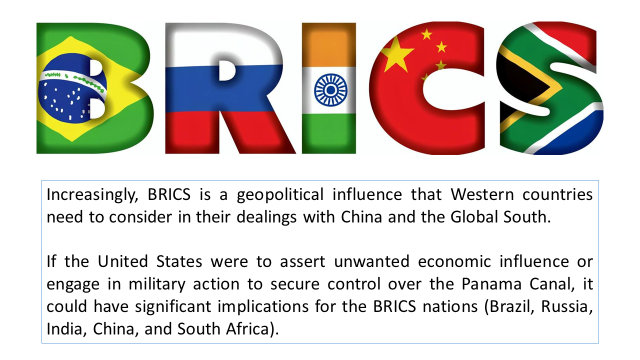
Such actions by the U.S. could alienate countries in Latin America and elsewhere, pushing them towards alternatives to U.S. hegemony. This would strengthen the appeal of BRICS as a counterbalance to Western influence.
Conclusion
Trump’s recent comments, while seen by some as inflammatory, have brought these issues back into the much-needed spotlight. They serve as a reminder of the enduring U.S. interest in maintaining influence in regions it once dominated. The situation in the Darien Gap further underscores how migration issues can become intertwined with geopolitical strategy, affecting not just Panama and the canal but international relations across continents.
It is also worthwhile to consider how this vital national interest, and Panama as a whole, has been allowed over the past quarter-century to move away from the United States and into the arms of China. China now carries influence throughout the small country and especially the Panama Canal. The seemingly purposeful dereliction of the isthmus is of great concern. Allowing China to control the canal provides them with a strategic advantage. It isolates and economically impacts the United States. Why has American foreign policy allowed this situation to occur? It seems to play to a greater globalist agenda.
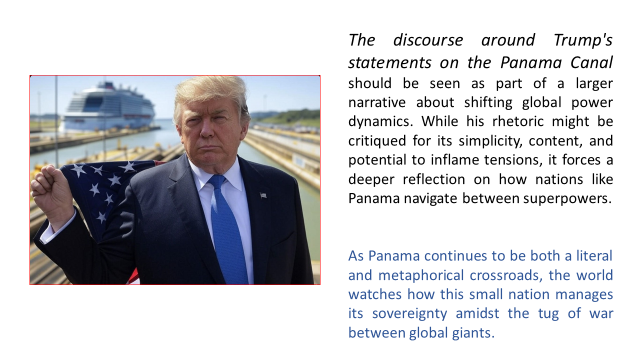
The Panamanian government has an obligation to its citizens, as well as international partners via agreements such as the Neutrality Treaty. A balance can be difficult to maintain. The infrastructure projects funded by China, the jobs they bring and the economic growth they generate are important to this small yet important nation. The professional management of its ports is equally important. Panama and the Panama Canal Authority have operated for the best interest of the country, working with China on many projects in the absence of meaningful help from its long-term friends, north of the border.
Other than in the strictest interpretation of the Neutrality Treaty, any military action would seem highly unwise unless greater conflict is desired. With national debt at an all time high, a faltering economy, wars in Europe and the Middle East and an ever-growing threat from Cartels the US already has enough on its plate without needlessly engaging in military action in Panama.
However, one thing is clear; President Trump is correct to highlight the Panama Canal. The U.S. now must find a diplomatic and economic solution to remove the threat of Chinese influence in Panama and the Panama Canal.
Join us.
republic.us
noglobalism.com
To Take Action to Save America’s Sovereignty and Your Freedoms
JOIN REPUBLIC- Promotion Code – 10$/mnth
SOURCES
https://youtu.be/px_6D47gdfo?si=lpY7p_vCQrr-eI7L
https://en.wikipedia.org/wiki/History_of_Panama?form=MG0AV3
https://en.wikipedia.org/wiki/Torrijos%E2%80%93Carter_Treaties
https://theconversation.com/the-panama-canals-forgotten-casualties-93536
TREATY CONCERNING THE PERMANENT NEUTRALITY AND OPERATION OF THE PANAMA CANALhttps://pancanal.com/en/end-of-the-construction/?form=MG0AV3
https://pancanal.com/en/tolls-then-and-now/
